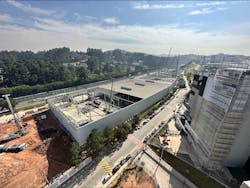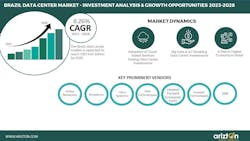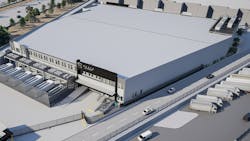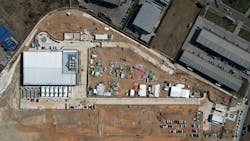Scala Data Centers’ CEO Puts Latin American Data Center Industry Into Global Perspective
Regarding the Latin American data center market and how it connects to the rest of the world, and particularly North America, DCF spoke recently with Marcos Peigo, co-founder and CEO of DigitalBridge’s LATAM data center powerhouse, Brazil-based Scala Data Centers, regarding the company’s many data center industry milestones and announcements this year.
Headquartered in Brazil and founded by Digital Bridge precursor Digital Colony in April 2020, Scala Data Centers was developed to meet and exceed growing demand for digital access in Latin America, and in just over three years' time has risen to arguably become the leading Latin American platform for sustainable data centers in the hyperscale market.
Scala's flagship sites include its Tamboré Campus in São Paulo, Brazil; its Porto Alegre city site in Rio Grande do Sul state, Brazil; and its Lampa site facilities in Chile, with projects to implement other data centers in Fortaleza city in Ceará state, Brazil, as well as in Mexico and Colombia. In 2023, the company started operating its three main data centers in Latin America, located in Rio de Janeiro at 13.2 MW of IT; in Tamboré, Brazil with 6 MW of IT capacity, and in Curauma, Chile offering 5 MW of IT.
Since the company's inception in 2020, Scala has invested more than R$ 8 billion (US$ 1.6 billion) in its projects in Latin America, and expects to reach 500 MW of distributed capacity over the next five years in four countries in which it operates.
Scala has experienced significant growth and expansion of capacity since the company’s inception in April of 2020 by tailoring its development approach to hyperscale customers and offering single tenant facilities. In our interview, Peigo explained how the company has wooed hyperscale customers with its deep knowledge of customer operations, leading to its rapid growth.
Via its Center of Excellence (CoE) program, Scala has almost 400 engineers on its books, dedicated to developing all data center operational functions, from design to construction management; and has started, delivered, or is in the middle of the process to deliver 120 MW this year alone - which Peigo notes is almost half of the whole Latin America market four years ago.
Scala's strategy for expanding in Latin America includes securing capacity in tier one markets and enabling tier two and three markets, as based out of its flagship campus in Tambore, with multiple buildings and power agreements around the LATAM region.
Peigo emphasized the importance of data center availability and predictability for hyperscale customers, and how Scala achieves these goals through strategic partnerships with vendors such as Caterpillar and Vertiv, among many others. Peigo explained how Scala standardized its data center solution and components for streamlined procurement and commitments in advance with vendors, allowing for shorter delivery times and predictable supply chains.
DigitalBridge gets into LATAM
As reported on by DCF at the time, Colony Capital acquired DigitalBridge, the owner of DataBank and Vantage Data Centers, for $325 million in 2019. That summer Colony raised $4 billion for its Digital Colony Partners initiative. The fund initially hoped to raise $3 billion, but was increased due to strong interest from institutional investors, including sovereign wealth funds, pension funds and insurance companies.
In April 2020, Digital Colony Management, LLC, the digital infrastructure investment platform of Colony Capital, established Scala Data Centers S/A as a hyperscale data center platform headquartered in Sao Paulo, through its acquisition of assets of UOL Diveo. Scala was Digital Colony’s second investment in Brazil and fourth in Latin America through its then-affiliate DigitalBridge, after acquiring Highline do Brasil in 2019, Andean Telecom Partners in 2017, and Mexico Towers Partners in 2013. Upon closing of the acquisition, Peigo, operating partner at Digital Colony, also became Chief Executive Officer of Scala Data Centers.
DigitalBridge CEO Marc Ganzi would succeed Thomas Barrack as CEO of Colony Capital in 2021, concurrent with Colony Capital changing its name to DigitalBridge, a rebranding move that aligned with Ganzi’s vision for a company driving the transition to a cloud-powered future. At that time, Ganzi said he saw DigitalBridge as the first truly global, diversified digital REIT.
Notably, despite market conditions during the pandemic, the DigitalBridge transaction to form Scala Data Centers followed the investor’s $14.3 billion acquisition of Zayo Group Holdings, Inc., operator of a 130,000-mile all-fiber network in North America and Europe, along with Zayo’s zColo colocation business, which operates 51 data centers and more than 1 million square feet of data center space, transactions which closed in March 2020; as well as the European expansion of DigitalBridge’s co-holding Vantage Data Centers through its acquisition of Next Generation Data.
With more than 20 years of experience leading technology and infrastructure focused firms, Peigo brought to Scala Data Centers critical insight into the Latin American market. Previous to 2020, he served as Vice President of Value Creation for IBM Latin America, where he led the company’s industry solutions, business development, architecture and innovation practices in the region. Before joining IBM, Peigo was Executive Director at UOL Diveo; Founder and Chief Executive Officer of Lemniscata Ventures, a Brazilian privately held investment company focused on ventures that have intensive use of IT as their core; and Chief Executive Officer of Solvo S/A, a managed services company focused on mission-critical infrastructure. In 2017, he was named the IT Executive of the Year, by Korn Ferry/ IT Midia.
Latin American data center markets assessment
Assessing Latin American data center markets for Data Center Hawk's "1Q 2023 Data Center Market Recap" report, the firm's David Liggitt said the Latin American data center industry's growth is currently surging, fueled by heavy technology adoption and data center investment. Data Center Hawk sees the LATAM data center market continuing to grow as more major hyperscalers seek to establish a foothold in the region. Liggitt projects the top three hyperscalers to each deploy an additional 500 MW by 2031 in key LATAM markets, accounting for close to 70% of newly deployed regional colocation.
As further reckoned by Liggitt:
"Prior to the pandemic, international firms in Dallas, Miami, and Los Angeles primarily serviced the region's data center needs since local enterprises had not yet outsourced their IT or undergone digital transformation. However, post-pandemic, Latin America is expected to see the highest global growth in technology adoption. This is expected to drive a regional 6X MW demand for colocation in key Latin American markets such as Mexico, Brazil, Chile, and Colombia over the next decade."
More Analysis of the Brazil, Chile, Mexico Data Center Markets
Recent data from technology industry analyst firm Arizton (Chicago) discerns more the $4.4 billion in investment opportunities in the Brazilian data center market by 2028, and notes that a host of submarine cables connect Brazil to several significant global markets. Arizton finds that Brazil is the major data center market which contributes more than 50% of data center investments in Latin America, with many data centers in the country providing hosting services to the cloud providers who drive such investments.
Arizton research released in March projects the Brazilian data center market to grow at a CAGR of 8.26% from 2022-2028. Stated drivers of the market include adoption of cloud-based services, 5G network connectivity, big data and internet of things (IoT) technologies, the adoption of AI, the rise of digitalization, and renewable energy procurement.The researcher also notes that the Brazilian data center market is witnessing the entry of foreign companies through the acquisition of local colocation service providers.
For example, in December 2022, US data center firm Aligned announced its acquisition of Brazilian colocation data center service firm ODATA, who is involved in the construction of the RJ01 Data Center (Phase 1) project in Rio de Janeiro, made operational in H1 2023. Other examples of foreign investors expanding their footprints in Brazil by acquiring local colocation providers incude Stonepeak's recent acquisition of Lumen Technologies' Latin American data center operations, rebranded as Cirion.
Arizton reckons that around 15 submarine cables connect the Brazilian data center industry to several significant markets. The Firmina submarine cable, which will be operational in 2023 and connects Brazil with Argentina, Uruguay, and the US, will be deployed next. Algar Telecom, Brisanet Telecommunications, Carlo Brazil, Vivo (Telefônica Brazil), TIM Brasil, Sercomtel, and other telecom providers are also contributing to the rollout of 5G network services throughout the nation. Additionally, the analyst found that many sectors in Brazil integrate 5G network services into their daily operations to automate services, improve communication efficiency, and implement remote monitoring. Approximately 56% of businesses in the country have 5G connectivity on their strategic agendas, according to KPMG Brazil. as reckoned by the analyst.
Further Arizton data released in March forecasts the data center market in Chile to reach an $876 million level of investment in 2028, with the market on pace to add over 150 MW in power capacity from 2023 through 2028. And as our interview with Peigo revealed, it is the Humboldt Cable Landing station, set to open by 2026 in Chile near the operator's newly opened Curauma data center campus, on which many of Scala's global designs settle.
2023: A big year for Scala Data Centers
The bulleted points below describe Scala's data center construction highlights for 2023, rounding up the major industry announcements made by the operator within just the past four months.
- Late this August, Scala Data Centers announced a US$80 million investment in the first hyperscale data center in Tepotzotlán, Mexico, about 25 miles from the country's capital, Mexico City. With an initial capacity of 5 MW extensible to a critical capacity of 7.9 MW, the 142,133 SF SMEXTP01 HyperEdge facility is set to meet the escalating demands of large cloud and content providers. Arizton expects the data center market in Mexico to reach investment of $1.15 billion by 2028, with huge demand for cloud computing boosting the adoption of greenfield facilities in the country. Scala said its investment in the Mexico facility offers key proximity for North American hyperscalers looking to bolster geographical diversity and boost service reliability and resilience against regional outages. Projected to begin operations in Q4 2023 and already anchored by a large hyperscale client, in line with the company's standard portfolio offering, the SMEXTP01 data center will offer customization and modularity capabilities and is supplied with 100% certified renewable energy. Peigo said the project underscores the company's commitment to enabling new markets in Latin America, both in unexplored locations and in regions with data center presence, where such markets may lack a dedicated approach to large IT capacities able to serve the hyperscale segment. Peigo said Scala's SMEXTP01 facility in Tepotzotlán will uniquely bring together an ideal scenario for the hyperscale market, involving energy availability, connectivity, and proximity to a large consumer market for critical IT infrastructure.
- Earlier in August, Scala announced its enablement of a new hyperscale market with its Curauma, Chile data center campus. Located in the country's Valparaíso cultural region, Scala's SSCLCR01 data center in Curauma starts operations with 5 MW of IT capacity, and launched 100% booked to a single hyperscale customer. Delivered in a timeframe of 10 months, with an investment of US$ 65 million at the time of announcement, the new site is the third data center inaugurated by the company in Latin America this year, and is poised for exponential growth, designed to reach a critical capacity of approximately 30 MW in coming years. In addition to the availability of land, energy, connectivity, and proximity to consolidated markets (the facility is based 56 miles from the Santiago metropolitan area) Curauma's profile will soon rise on the world's connectivity map with the arrival of the Humboldt submarine cable by 2026, which will connect Latin America to the Asia-Pacific regions for the first time. Across approximately 9,500 miles of fiber, the Humboldt subsea cable will bring lower latency and greater connection quality at scale between Latin America, Asia, and Oceania. The Curauma data center will also have connection with the U.S. West Coast. Peigo said that where 5G accelerates the deployment of various services and applications that use high data volume and require low latency, the launch of a campus in Chile was strategically aligned with Scala's purpose of enabling the future in Latin America by creating a unique opportunity for customers positioned on the West Coast of the U.S., and for a potential group in APAC (Asia-Pacific and China) to offer their products and solutions to Latin American customers. With high efficiency in the use of its resources, the operator stated that the Curauma SSCLCR01 data center was designed to operate with a PUE lower than 1.2-1.3 and with a WUE of zero, as it uses air cooling. All SSCLCR01 data center monitoring will be conducted by the company's Command Center unit, located at its operational headquarters in São Paulo, where a trilingual team extensively uses technology, artificial intelligence, and rigorous quality processes to monitor and ensure security, in line with Scala's other sites in operation. In addition to Curauma Campus, Scala's growth in Chile continues with its ongoing construction of its Lampa Campus in the metropolitan region of Santiago, representing the largest data center campus ever built in Chile, with an eventual IT capacity of 80 MW, to begin operations at 30 MW for initial delivery in 2024.
- It must be noted that, as announced in July, for four years in a row, Scala Data Centers was named as Colocation Quadrant leader in Brazil by the ISG Provider Lens™ 2023 study, in the category of Private/Hybrid Cloud – Data Center Services. The analyst said Scala further enhanced its rankings in "Competitive Strength" and "Portfolio Attractiveness," when compared to the report's previous year. The ISG analysis sheds light on Scala's commercial and operational strategy, demonstrating the company's dedication to catering to hyperscale market demands. Notably, the report emphasizes Scala's proficiency in constructing modular data centers within tight timelines, and the company's strategic positioning to cater to long-term projects. The report reveals the company has reserved over 1 million square meters of properties for future data centers. According to Pedro Bicudo Maschio, ISG Provider Lens Lead Author, Scala stands out for its exceptional flexibility in constructing and delivering customized data centers tailored to meet customers' specific demands. "Scala Data Centers commits to customers' expansion plans, ensuring a supply chain of clean energy, hyperconnectivity, engineering support, available properties and construction capacity that is fast, fully sustainable and highly efficient," Bicudo Maschio said. You can download the full study here.
- In May, Scala heralded the startup of its 6 MW IT SGRUTB05 data center, billed as "the second largest vertical data center in Latin America." Located in the operator's flagship Tamboré Campus, the building, in Barueri city, São Paulo state, Brazil, is another single-tenant facility, one of three in the campus, dedicated to a single hyperscale customer. The facility has a reserved capacity of 100 MW to be distributed in other data centers at the complex. Also located on the campus, is Scala's SGRUTB04, the largest vertical data center in the Latin American market. With a total built area of 6,700 sqm, SGRUTB05 is 35.5 meters high, has five floors, three of which are dedicated to data halls, which together have a high density of approximately 400 racks with almost 9 MW of total power.
- Also in May, Scala announced its signing of an open letter published by the leadership of the iMasons Climate Accord (ICA) that encourages the adoption of technologies surrounding the use of greener concrete. The initiative seeks to promote the usage of sustainable raw materials in the data center industry globally. The ICA's open letter points out that concrete, steel, and aluminum production is responsible for 23% of total global carbon emissions, while concrete alone makes up 11%. Thus, the ICA recommends using the smallest amount of concrete possible; or specifying and using the lowest-carbon concrete, as the material is available in scale for the market and meets structural, performance and cost criteria. Currently, there are solutions that make it possible to reduce the use of ordinary cement and, consequently, reduce emissions from concrete production. Among them, limestone calcined clay cement (LC3) stands out, which has a carbon footprint around 40% lower than traditional. This and other solutions such as alkali activated cement based on waste metals, calcium sulfoaluminate (CSA), geopolymers and glass pozzolans from recycled glass can increase potential emission reductions by up to 70% and expand the pool of alternative cementitious materials. Scala committed to study and assess the adoption of such sustainable input technologies and processes in its data centers, in line with its robust ESG program.
The Data Center Frontier Interview with Scala Data Centers’ Co-Founder and CEO Marcos Peigo
Here follows highlights of DCF’s recent, wide-ranging interview with Scala’s Marcos Peigo, presented in the form of a testimonial essay by the man himself. The excerpted remarks have been lightly edited for clarity.
We are in the middle of two things happening in the company. One is a big capitalization to support our growth - I'm in constant calls with investors because we are raising more capital to keep deploying this massive growth for Scala. We are negotiating a big agreement that I expect to share with you in the following weeks related to machine learning in Latin America. We have a uniqueness to Scala that enabled this success, which is basically growing this company by, as of today's booking, nine times bigger than its inception in April 2020 – like 900% growth in three years and three months, which is crazy.
We decided to launch Scala - which was not Scala at the time - when DigitalBridge decided to invest in Latin America to create a Latin American data center platform. Back in December 2019, I was invited to join as a co-founder and a partner to invest into the company. The idea in principle was not to run the company, it was to be a board member and investor in the company, given my experience in Latin America and my previous experience with the UOLDIVEO assets.
The way DigitalBridge found to enter into the market, taking a shortcut, was to acquire established data centers that they could use to launch the platform. We started by acquiring two data centers from UOL. UOL is the largest internet communications company in Brazil, handling newspaper payment methods and internet portals. I had a previous history with the asset because I sold my IT services company to UOL back in 2012, and I ran UOLDIVEO from 2012 to 2017. I launched the hyperscale initiative there back in 2014 when we signed our first agreement with the hyperscale customers. So the combination of myself being a serial entrepreneur, very well-seasoned on the IT landscape in Latin America, plus my previous history with the asset, DigitalBridge invited me to join the party.
The idea was we would launch, how can I say this, 'just another data center company' - which was basically: the same playbook, different geography. Let's be the same as the others. We are going to be backed by a massive amount of capital to deploy. We are going to focus a significant portion of the company in the hyperscale customer, but it's still a significant portion of the company in the enterprise market. So we would be like a kind of centi-Equinix, where we are going to provide for a wide range of customers. Then a small adjustment to our business plan happened, which was the pandemic.
During the pandemic, we saw two things. First, the demand for the market had completely changed. There were a few factors that we already believed at the time that would change dynamics of the market: data sovereignty issues; the pace of digitalization with local customers migrating to the cloud at a higher level than before; plus the demand for lower latency in United States, which would force cloud providers to release space in Virginia, for example, and bring capacity to serve Latin American customers, instead of exporting cloud services to them. Plus, the currency disruption, which is constant in our region, where large enterprise customers don’t want to pay USD dollars for services they are consuming in the country.
These factors were just accelerated by the demand of the pandemic, plus the constraints in capacity and power in Virginia, which was the key hub to provide services from hyperscalers to Latin America. When we saw that, and we were also constrained by our ability to touch point with the whole enterprise market, we decided to focus only on hyperscale customers, leverage the relationship in place with a few of them at the time, and invest into a new type of deployment that is not the regular colocation.
We saw the hyperscale market was not established in LATAM. This can sound a little bit arrogant, to consider ourselves the founders of the hyperscale market in LATAM - we are not, because the hyperscale customers were here, but the hyperscale market was not. The average deployment for a hyperscale customer before the pandemic was 2 MW contracts, insured facilities. We were the first one to go to a level of 5, 6, 10 megawatts per contract. Now we are negotiating 100 MW in a single contract, but offering to these customers single tenant facilities.
Everything we have sold from April 2020 up to the end of last year was just single tenant buildings. We jumped from racks and cages and data halls to full buildings with what this type of agreement drives - long term agreements, power purchase agreements embedded into that, fully customized data centers and a very deep knowledge of how these customers operate, what they want, how they grow.
How can we convince them that they can plan for the following years with us and not just for the immediate capacity? We were not building a data center anymore before we have the demand, just with an anchor customer, and then sharing that space with several customers, and when we reach 50, 70, 80% of company occupation, which varies from company to company, we would start the second data center.
So that turned upside down the way to approach hyperscalers, which was not to respond to demand anymore, but to offer capacity in places we could deliver progressive growth and expansion capacity, and add to that also strategic locations, [taking] Curauma as an example, which is a site that we just put live for the first hyperscale customer.
Curauma is on the Pacific shore and that happens to be the place where the Humboldt Cable will connect Japan, China, New Zealand and Australia with the shortest and cheapest path to Latin America. When we had the confirmation of that location and where the CLS would be established, we decided there is going to be a Scala data center there and that's going to be our beachhead for the APAC invasion. What is the APAC invasion? It's basically the same thing that American cloud companies did in the past by providing cheap Infrastructure as a Service to Latin American customers served by us. With this level of latency, the Chinese cloud and the APAC customers can explore Latin America as well.
When the first hyperscaler agreed with us for our overall strategy, we saw ourselves in the middle of the pandemic with the huge challenge of delivering the first single tenant building for one of the most demanding hyperscale companies in the world, with a first of a kind N+2C architecture with batteries embedded into the rack, within a very tight schedule. This building was 9 MW - at that time, the biggest building in LATAM. I need to be honest with you, I'm a control freak. [Nevertheless] I saw that our success, which would be the starting phase for Scala as a platform, would be trusted to third parties that would get our money to learn about the hyperscale market during the pandemic.
We decided to vertically integrate everything from design to the management of construction. Then we decided to take a different approach: instead of hiring a general contractor, we contracted dozens of smaller companies specialized in different parts of a data center design, construction, bringing people and companies from other industries that were not originally from the data center industry. If you look to my engineering and construction team today, they build nuclear submarines, they build dams, they build roads, they build metros, they build airports. Then we brought this experience of engaging different types of challenges to data center demand. That was the kickoff of our Center of Excellence. Today, we have almost 400 engineers dedicated to all the functions from design to construction management at Scala, which is by itself a unique feature of Scala in LATAM - none of my competitors rely on that.
When you look at Scala, you can clearly see four divisions in the company. One is my real estate and power company. Then you can see a manufacturing company, which is not our company, but a partner that works for us according to our definitions, where we leverage heavily industrialization as part of our design that goes from concrete precast up to data center modules that can be added either in components, electrical rooms, cooling rooms, or data halls to enable what we call Fast Deploy, which is our solution to deploy our HyperEdge facilities, which are basically five to 10 MW facilities in what you would call, for us, tier two and tier three markets.
We decided to leverage our IT services experience to enable a consolidated platform that could work as a regional hub for Latin America. When you think about Scala, forget about what you learned in geography lessons that Colombia, Mexico, Chile and Brazil are different countries. For us, they are just Latin America.
We cherry-picked from the ecosystem of vendors a few companies like Caterpillar and Vertiv, which are publicly announced partnerships where we are not doing anymore what the market does generally, which is procurement. We moved it from standard procurement, which is basically buying what is cheapest and available at that time, to strategic partnerships. We invested thousands and thousands of engineering hours to standardize our solution.
We use artificial intelligence. We have robot dogs surveilling the perimeter. We have a lot of stuff that is high tech for the data center industry, but it was not high tech for the IT industry, and this is the combination of stuff that makes Scala a different animal, adding to that a very strict guidance over ESG. When you take Latin America with 1.74 average PUE, our data centers are all under 1.35 by design and implementation. When you see the history of Scala, we were the first data center to use only 100% of renewable energy since our inception, and we were the first one in Americas to achieve certified carbon neutrality.
When you see what we built, we were not looking for this. Machine learning came as the pandemic came, and by not having a legacy and having the CoE and being able to quickly come up with a solution and having the land, the power securities, we are enabling a different future in Latin America, where machine learning can be housed here to support the whole of the Americas.
I really think that Latin America was underserved in terms of data center capacity. Now we're not underserved anymore, even because Scala is changing that, but we are underserved in terms of attention on how promising the market is. What is nice to see is that Scala did so well, that we are bringing attention from local investors and local banks that never saw the data center industry as a serious industry. And why is that? Because the data center industry in Brazil was not a hyperscale industry. It was a pulverized, shared industry with several enterprise retail companies, where you couldn't see predictability in the cash flows.
I will tell you the only constraint that we have today. Assuming that we have already secured our land bank, and we have already secured the power that we need to enable this portfolio, which would be the natural two items. (I would love to secure more power in Mexico, for example, but we adapted. We changed Mexico from the second country to the fourth country in our strategy and we are fine with that.)
My big challenge is to fund the business. My capex for this year alone is $1.3 billion. You take inflation, the cost of money, the lack of capital, and American investors trying to understand, what is inflation? I was born into inflation, I work with inflation, running or owning 20 companies in 25 years, living with inflation. But now half of my time is devoted to educating investors on how to live with inflation and how to invest with inflation.
Being as creative as we are on the engineering side, we are creating alternative sources of funding, vendor financing, customer financing. This is the only concern I have: how fast can I keep growing, and how fast the money will flow, period.
-- Marcos Peigo, Co-Founder and CEO, Scala Data Centers
About the Author
Matt Vincent
A B2B technology journalist and editor with more than two decades of experience, Matt Vincent is Editor in Chief of Data Center Frontier.







